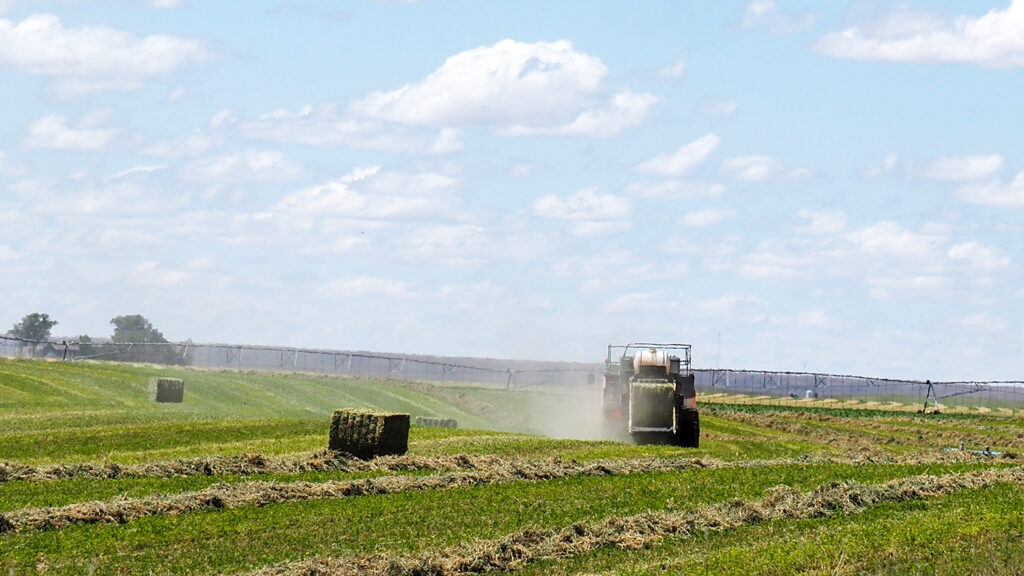A farmer bales a crop on an irrigated field in southwest Kansas (Kevin Hardy/Stateline).
Congress couldn’t pass a new farm bill last year, so it punted. The extension of the old bill ends in less than a month, on Sept. 30. It will likely miss that deadline, too, an unprecedented two-year delay.
Farm state representatives predict doom without a new farm bill. They would have us believe we will go hungry and sit naked while parked in line to gas our cars. Scare tactics. Continuing the existing law might be the better option.
Instead of writing a new farm bill, working on policy instead of politics, the least productive House in generations spent 21 days flailing and replacing the speaker — internecine nonsense. It wasted time on bills with no prospect of becoming law, messaging bills: the Stop Unaffordable Dishwasher Standards Act, the Refrigerator Freedom Act and the Save Our Gas Stoves Act. It also found time to rename a slew of post offices and other federal buildings, including the National Museum of Play. But it couldn’t pass a farm bill.
Then the House went on vacation for the summer, one week earlier than planned. It will be in session just 13 more days this year. More, maybe, if it convenes a post-election lame duck session. Its top priority will be avoiding a government shutdown — as well as funding its own pay, which it also failed to accomplish.
Even that is in jeopardy. House leadership seems intent on attaching another messaging bill to its government spending legislation. Congress will spend the few days remaining before the farm bill extension expires on a proposal restating existing voter eligibility requirements in every state, including Kansas.
The distinguishing feature of the proposed 2024 farm bill the House Agriculture Committee wrote is its stunning price tag. It will spend more than $1 trillion, $43 billion dollars more than the current law, but not because it changes policy. It simply adds money to existing programs, making them even more lucrative. The Senate agriculture committee has yet to produce anything.
Boosts in subsidies for individual crops — as much as 20% — account for most of the new spending. At the same time, the limit a single farm can earn will jump almost 25%. The bill carves new exemptions into the caps that restrict the largest, richest farmers from receiving payments. These two changes cost more than $1 billion dollars.
Supporters have not offered a compelling case for this bill. They argue that lower prices justify raising subsidy levels, but for some of the key crops, prices are 10-20% higher than when the current bill was written.
The rationale appears to be the mere fact that farm spending has not increased. This is a plainly stated version of the House committee’s justification for its bill: We haven’t increased spending in a long time so therefore we have to increase spending.
Not only are they peddling a mindboggling budget buster without a persuasive policy rationale but they are also failing farm bill politics 101.
Wheat farmers alone have never passed a farm bill. Corn growers and cotton ginners, the sugar boys, ag lenders, cowboys and dairy farmers, fruit and vegetable producers, and more must get on board. But they are only half the political equation.
Every senator has some agricultural constituency. Only about 75 members of the House represent purely rural districts. But every district includes voters who eat, and every farm bill has depended on support from metropolitan and suburban non-farm votes.
Instead of building a coalition, adding support, the House Agriculture Committee is subtracting. Non-farm, urban members who in the past voted for farm bills — because of the food assistance and nutrition provisions — are jumping ship. This bill would hurt their constituents in Philadelphia and Houston, as well as Kansans in Dodge City, Coffeyville and Liberal. Some of the highest participation rates in these programs are in rural Kansas.
The House bill proposes the largest cut in 30 years to food stamps — now known as the Supplemental Nutrition Assistance Program. For every dollar it cuts from SNAP, it adds two dollars in new farm subsidies. It would eliminate 40 million recipients from the program, including 17 million children. In Kansas, for every farmer receiving more in subsidies, SNAP benefits for approximately four Kansans would fall.
The historic farm-food alliance is wildly out of balance in this bill.
The first sentence of the original food stamp act declares its purpose: “To strengthen the agricultural economy” and that “establishing and maintaining adequate national levels of nutrition will … strengthen our agricultural economy.”
They are no longer common along Kansas highways, though a few remain — the billboards proclaiming: “If you eat, thank a farmer.”
Maybe it’s time for some new ones: “If you’re a farmer, thank an eater and a taxpayer.”
This commentary was originally published by Kansas Reflector, a States Newsroom affiliate.

